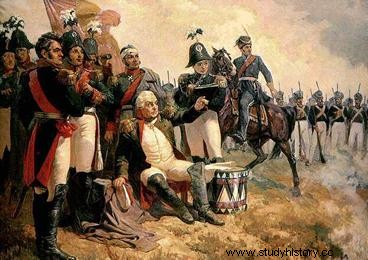
Mikhail Illarionovich Golenishchev-Koutousov, Prince of Smolensk, born in 1745 in Saint-Petersburg and died on April 28, 1813 in Bunzlau in Silesia. General-in-chief of the armies of Russia, during the reign of Tsar Alexander I of Russia, winner of Napoleon's Grande Armée during the Russian campaign of 1812.
Son of a military engineer, he embraced the career of arms from the age of 12. In 1759, he joined the Russian army, when he was only 14 years old. He knows six languages, arithmetic and geography. Beginning in the artillery corps of Empress Catherine II of Russia, he took part in the campaigns in Poland (1764-1769) and Ukraine before distinguishing himself in the war against the Turks in 1788-1792. A bullet went through his head in 1773:he lost his right eye. He then served under the orders of his mentor, General Alexander Suvorov. In 1788, he was close to death once again. He recovers in time to take an active part in the last battles against the Turks.
Kutousov attended the siege of Otchakov in 1788, where he showed great firmness. He is dangerously wounded in a vigorous outing of the Turkish garrison. He then took a large part in the capture of Izmail in 1790. In 1791 he was appointed lieutenant-general, then given command of an army corps placed between the Prut, the Dniester and the Danube. After the peace with the Turks, he obtained the command of Ukraine and took part in several diplomatic negotiations, both during the reign of Empress Catherine II of Russia and under that of his successor, Tsar Paul I of Russia. He successively became ambassador to Constantinople, governor-general of Finland, commander of the corps of cadets in Saint Petersburg, ambassador to Berlin, military governor of Saint Petersburg.
Perhaps because he refused to participate in the plot against Tsar Paul I, Alexander I, who in turn became Tsar, dismissed him from important positions.
Koutuzov, during the Napoleonic Wars
In 1805, at the time of the third coalition against France, Kutousov was 60 years old. He is a popular chef because of his immoderate taste for alcohol and women, which does not prevent everyone from agreeing to find him courteous, cultured and cunning. Alexander I of Russia instructs him to support the Austrians against Napoleon. He confronted Marshal Joseph Mortier at Dürrenstein in November 1805.
At Austerlitz, he advises against giving battle. But the Tsar, present on the battlefield, turned a deaf ear. After the defeat, Kutousov, who was wrong to be right, again falls into disfavor. He is assigned
In 1811, the decisive victories he won against the Turks in Moldavia dictated the conditions of peace during the Treaty of Bucharest on March 16, 1812:Eastern Moldavia (known as Bessarabia, current Republic of Moldavia) became Russian. After the Peace of Pressburg. At that time he was elevated to the dignities of prince, president of the Council of State and field-marshal.
The Tsar again entrusted him with the command of the Russian army during the French invasion of the Russian campaign. Koutousov then applied the scorched earth policy over nearly 2000 km between the Russian border and Moscow. Avoiding the confrontation that would be fatal to him until the end, he let the 200,000 men of the great army approach Moscow under the incessant harassment of the Cossacks, which are reminiscent of the Spanish guerrillas. Then, he finally decides, at the gates of Moscow, to give battle. This is the Battle of the Moskowa (or Borodino).
Defeated, the Russian army opens the road to the capital, which the French find abandoned. The city, built of wood, was entirely burned from September 14 to 20, depriving the 200,000 men of the Grande Armée of shelter for the winter, without it being possible to really say who, French or Russian, was really responsible. of this fire:Probably a bit of both, French looters, Russian looters...
Napoleon was then forced, on October 18, in the middle of the Russian winter, to give the order to retreat. Koutouzov then followed the routed army, which he harassed with small groups. The battles of Dorogobon and the battle of Krasnoi, where numbers nevertheless crush valor, earned Kutusov the nickname of Smolenskoy and the great cordon of Saint-Georges.
See the article Battle of the Moskowa.
During the passage of the Berezina, the remains of the Grande Armée narrowly escaped him.
This field-marshal still commanded the Russian army at the beginning of 1813. But suffering from sepsis, following his numerous wounds, he died at Buntzlau in Silesia on April 6, 1813, when he took command of the Allied forces of the sixth coalition and is preparing to launch an offensive against Napoleon's forces.
Posterity
A memorial was erected at the place of his death, on the Poklonnaya in Moscow and in front of the Cathedral of Our Lady of Kazan in Saint Petersburg, where he is buried. Having no direct male heirs, her estate went to the Tolstoy family.
The Russian poet, playwright and novelist Aleksandr Pushkin dedicated a famous eulogy to the Marshal's burial place. In War and Peace, Leo Tolstoy depicts him as an intelligent and valued leader
During the German offensive (1941-45), the Soviet government created the Order of Kutuzov. Today, after the fall of the Soviet Union, it is still one of the highest honors in Russia. Along with his master General Alexsandre Suvorov, Kutuzov is considered one of the greatest Russian generals.
